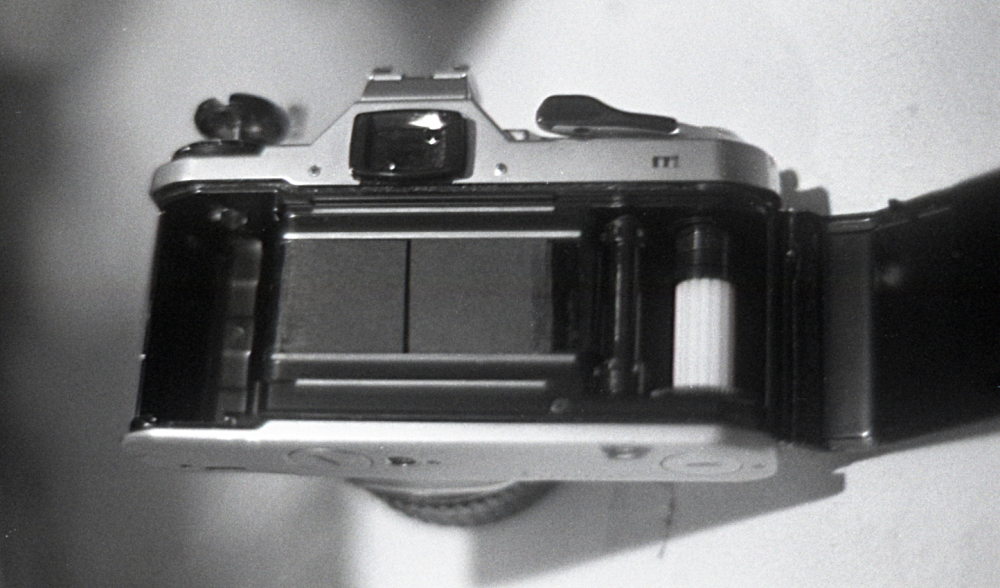
This picture shows the slot installed at the focal plane
Additional advanced calculations and info can be found here.

Panoramicam is the name I gave to my moving-slit camera. A camera of this design can make 360+ degree panoramic photographs on one strip of film in a continuous exposure. In addition, interesting effects result from the subtle interplay of the camera and subject motion. I made this camera in 2009 out of an old worn-out Pentax 35mm camera and inkjet printer parts.
A moving-slit camera works by rotating the camera around the lens nodal point at a precise rate so that the image sweeps across the film as the horizontal pan proceeds. At the same time, the film itself is moved sideways through the film gate so that it moves at the same rate the image is moving from the panning. To achieve reasonable exposure and reduce lens distortion, the film gate is covered by a mask except for a vertical slit located directly in the middle. If this dance can be done precisely, a sharp image will result, and the length of the image is limited only by the amount of film the camera will hold. Cameras built on this principle using clockwork and large-format film have been around for about a hundred years. Panoramicam uses 35mm film and digital electronics, providing a compact moving-slit camera that generates negatives which are easily printable with a 4x5 enlarger.
I always liked the moving-slit camera concept, but original clockwork cameras are rare, expensive, and hardly portable or versatile. However, the large-format negatives that these cameras used can be directly contact-printed in the darkroom to provide finished prints. In designing a moving-slit camera of my own, I had to consider what I would do with the resulting negatives. I first considered using common 120-sized roll film--large, versatile film used in cameras like Hasselblads and Holgas. However, such a negative, while large enough to provide high resolution, would make a rather small, 2-inch tall contact print. Yet, the negatives would be too big to enlarge without building a matching moving-slit enlarger, since no common photo enlarger could print the wide panoramic negatives that would result. In the end I designed the camera to use 35mm film. A strip of 35mm film can hold a very wide, 1:5 ratio image and still be printable with a 4x5 enlarger. Luckily, modern tabular-grain films have extremely high resolution and fine grain, and the design of the moving-slit camera allows generous exposure, so that grainy high-speed film is not needed. By using the very best 35mm film, I could achieve this kind of compact, inexpensive camera and make panoramic negatives that I could easily print in my darkroom with an ordinary enlarger.
Panoramicam, like most of my projects, was constrained by an extremely small budget and lack of proper machining tools, so its design reflects the fact that it had to be made with hand tools on the kitchen table in my apartment (I have a very understanding wife). It is built on a platform made from a plastic cutting-board. For the rotating pivot, I used a 5/16 bolt for an axle so that I could use a set of slightly-worn skateboard bearings. I predicted that a very smooth pivot would be important to getting sharp images. After puzzling over how to interface the skateboard bearings to the base without machining capabilities, I eventually found an unimpressive but perfectly-designed solution in the form of a worn-out skateboard wheel. My extremely well-used and loved Pentax ME Super was slightly modified with a film mask and a pully attached to the film-rewind crank. Like everyone else, I have a box full of old inkjet printer motors and opto-encoders, which I put to good use after calculating the appropriate gear ratios. The encoder for the film travel is a mechanical encoder taken from an old Microsoft mouse. For the brains, I used a Boarduino clone from AVRThing.com.

This picture shows the slot installed at the focal plane
In practice, proper exposure settings are calculated and the camera configured for proper exposure. Exposure can be modified by changing the platform rotation speed with DIP-switches, by changing the camera aperture, and least conveniently, by changing the slit width. As calculated, the daylight exposure is dead-on at f/11 with the fastest rotation speed and thinnest slit, leaving a lot of "room at the bottom" for dimmer conditions. Depth of field at this magnification is generally great enough that focus is not an issue. Once situated, the camera is loaded with film and the whole roll fired off with the lens cap on, leaving it in a "ready to rewind" state. Then the rewind button is pressed, allowing the electronics to "rewind" the film at the precisely calculated speed to match the platform rotation, with the camera's original shutter locked open. The programming is thorough enough to allow multiple exposures on the same roll, and short rolls can be loaded if desired.